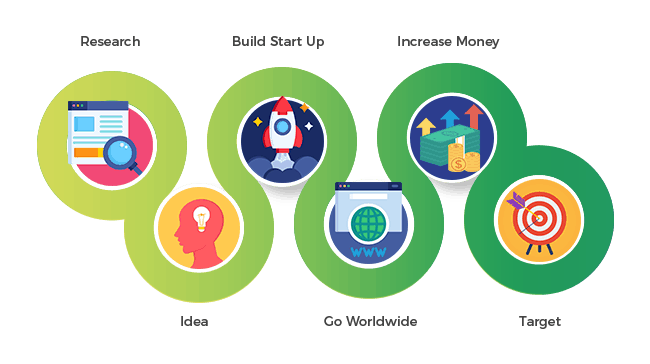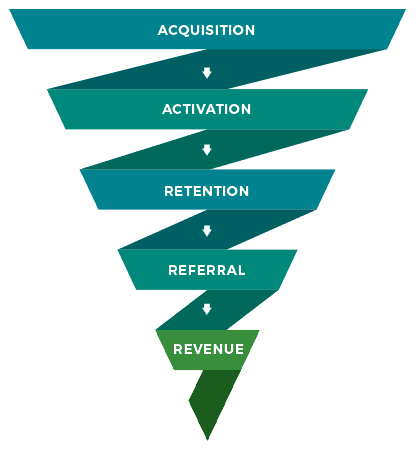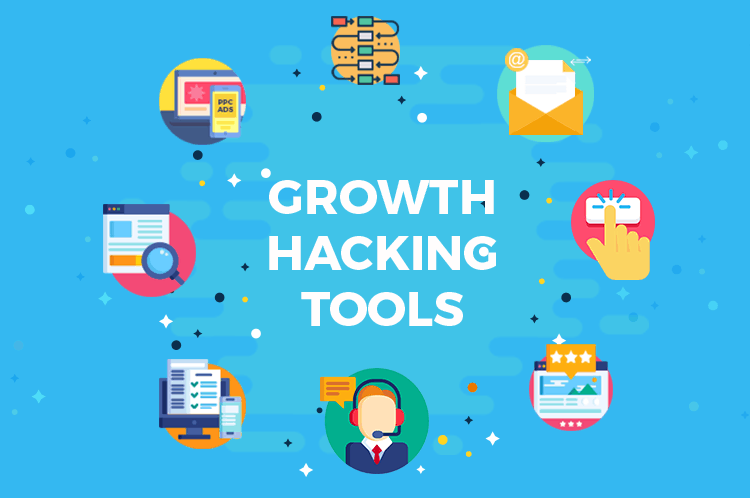The Ultimate Step-by-Step Growth Hacking Guide
Competition is fierce. Startup companies sometimes flounder because they aren’t growing fast enough to keep up. Growth hacking can give them an edge on their competition, make them profitable and help them expand into authoritative businesses with worldwide reach. Connecting with companies who specialize in growth hacking can be a smart business strategy for startups.
What is Growth Hacking
In the start-up world, growth hacking is a sometimes-elusive term.
Entrepreneur Sean Ellis, who helped Dropbox achieve its magnificent growth success, coined the phrase “growth hacker” as a job description to help the companies he worked with find a replacement for him.
The term circulated through the business community. It stuck because it touches a tender spot for both start-ups and established businesses: in order to survive in today’s economy, businesses need to grow.
Growth can’t be limited, either. Businesses need to grow up and out, in every direction, to survive and thrive.
Defining growth
In the botany world, growth is when a plant gets bigger, stronger, and capable of replicating itself. In the animal kingdom, it’s nearly the same, with young animals gaining strength and size, maturing into adults that can reproduce.
As simplistic as it sounds, these concepts can be applied to the business world, too.
- Energy: start-ups need to be nurtured. As in nature, there’s a need for young enterprises to be fed. They need the proper amount of resources—and the right kind—to stay healthy and grow.
- Enlargement: growth means getting bigger. It takes up more space. Sometimes this is literal, with businesses strategically opening up offices in new geographic areas. However, it can also mean digital real estate, in which a company’s reach expands to new customer bases, new markets, and even new countries.
- Production: businesses need to offer something of value that can be used by society. This takes the form of goods and services, whether it’s physical or electronic.
The problem is, it’s difficult to see the future. Even when start-ups are watching the trends and acting on solid hunches, there’s so much information available now that it’s difficult to keep up.
How do they find the best areas to expand to? How do they know which goods or services to focus their production efforts on?
This is where hacking comes in.
Defining hacking—and adding it to growth
The idea of hacking is well established in the digital world. General dictionary definitions describe it as using a computer to gain unauthorized access to private accounts.
Online, this has expanded to ideas such as life-hacking, which helps explain the concept. It’s about using the resources you’ve got to make the tasks at hand easier and more effective.
It’s strategy.
When it’s applied to business growth, it implies originality, thinking out of the box, and finding ways to reach more customers. It goes beyond basic marketing, often requiring a specialist to design an individualized strategy to help skyrocket sales.
Growth hacking can take the form of offering freebies, drawing exclusive circles of clients, and finding the right partners. Ultimately, it’s about using your unique insights and resources to grow your business exponentially—and often in surprising, innovative ways.
3 Things Growth Hackers Do
Since growth hacking is about finding new ways to go, growth hackers have a big job. They have to be on top of all of the information, and they have to continuously keep an eye on the future. Being able to see the big picture and then zero in on the details—without losing perspective—is both tricky and imperative.
Growth Hackers Watch the Trends
Information overload is a thing, but it’s a risk growth hackers are willing to take. If they can navigate through the data successfully, they have a chance of giving their company that subtle edge that can make them leaders in their industry.
Here’s what growth hackers have to keep their eyes on:
- Economics: In the international business world, knowing exchange rates is a must. You’ve got to know what your services are worth, where they have value in the world, and how much people are willing to pay. Beyond that, you’ve got to know which countries and companies are economically strong enough to invest in you. Also, if the market is shaky, you’ve got to know what your options are.
- Electronics: The digital world is continually evolving. Keeping an eye on the electronic side of things means watching the new types of hardware (and software) coming out. Growth hackers consider things like updating hardware to handle larger customer bases, investing in programs that will increase efficiency, or installing the best infrastructure to support internet growth for decades. They know what’s already out there and are looking ahead to the next big thing, always considering the best ways to implement new technology for business growth.
- Social and Cultural Leanings: One thing all business deals have in common is that people are involved. Start-ups have to be aware of the human interactions laced through their business processes. In order to compete effectively, growth hackers understand societal trends and the impact cultures have on their sales. Maybe pink just isn’t in this year—or maybe a country’s political strife makes it a high risk for investment.
There’s so much data to watch that it can be difficult for a startup company (even one that has a marketing department) to keep up. Opting to outsource a growth-hacking specialist can help pinpoint the top metrics to follow and get aim a new marketing department in the right direction.
Growth Hackers Understand the Tools
There are some surprisingly simple tools for growth-hacking that are often overlooked. Email lists, SEO, calls-to-action and customer service, may have been around for decades, but that’s because they’re valuable tools for growth.
Growth hackers understand the value of using the best software and internet apps to grow their businesses, too. Software to help with SEO, to integrate marketing and sales, and to analyze the data from ad campaigns and competitors can help growth hackers watch the trends and decide where to invest next.
Some of the best tools for growth are embedded in social media, and growth hackers know that. From PPC ads with Google AdWords to content marketing on LinkedIn, they use social platforms to increase their reach and draw in leads.
Growth Hackers Get the Overall Goal
Growth hackers are great at linking company goals with processes that will help them reach those goals. They’re constantly surrounded by a buzz of data and incoming info; they don’t lose their sense of perspective. When it’s all said and done, they know their only real objective is to position the company for maximum growth.
Who are the Growth-Hacking Geniuses?
Growth hacking is responsible for how a handful of small start-ups every year manages to achieve astounding growth and wow the socks off society. Facebook, Airbnb, and Dropbox are common names now—but that’s because a few key people understood how to grow the companies they worked for.
Most start-ups don’t have that advantage. For them, hiring an outside consultant to focus specifically on growth hacking can be one of the smartest moves they make. An outsourced growth hacker can also help train in-house employees to think like growth hackers, which can help the entire company over the long term.
The job description within a company almost doesn’t matter. An engineer can be a growth hacker just as easily as a marketer can. The important thing is their focus. If any employee is concentrating on ways to help grow the company—especially if it’s trying new territory—that person is a growth hacker.
Consider the following ways that growth hacking might be happening in various companies:
- A CEO whose vision for the company includes integrating customer service with marketing in an attempt to enhance their repeat customer base
- A marketing analyst who suggests the purchase of new software for monitoring internet buzz about similar products overseas
- A marketing executive who promotes developing innovative and valuable content for inbound marketing as well as outbound marketing
- A software engineer with an idea for speeding up the sales funnel by including more digital rewards for potential customers
- A web designer whose work makes the storefront intuitive, user-friendly and finds a way to make the purchaser smile
While their efforts may or may not work, they’re trying new things, testing out new areas with minimal risk and the potential for expansion.
With that in mind, the best company culture would be one filled with growth hackers in every department and at every level. Hiring an outside team of marketing pros so the startup can focus its efforts on development will free up those employees so they can learn HOW to think like a growth hacker.
Hiring a growth hacker to plan a growth strategy could also include watching the company’s reputation. Without that extra pressure, startups can focus on fine-tuning other aspects of how the company runs.
3 Quick Ways to Promote a Growth-Hacking Culture
Growth happens best when it happens on every level. Here are some ideas for making your start-up company innovative and future-focused.
- Don’t ignore the impossible. Assign an ‘impossibility squad’ to list things that are impossible for the company to do with its resources right now, but that might be feasible in the future. Have the squad periodically list the current ‘impossibilities,’ assess where the company is at and brainstorm ways to move toward making the impossible become a dream come true. You can include staff from every level of and every department—and make it fun—to make focusing on company growth important to everyone.
- Think about how you communicate your brand. As with the impossibility squad, find ways to reward company employees who use your branding strategies whenever and wherever they can. Teaching digital marketing skills even to the lowest employees in the company can pay off if people see your brand on their personal social media sites. It becomes word-of-mouth marketing from the inside out. Have the impossibility squad work with an outsourced growth hacker to find the best strategies and solutions for your company and find ways to implement them.
- Provide your people with the best tools. A marketer who can’t monitor new trends in SEO or competitor data won’t be as effective as one who has access to all the new information. Invest in the tools that will make life easier for your employees so you can get their best work in return. This is another area where an outsourced growth hacker can provide excellent feedback and information.
Filtering through the Growth-Hack Funnel
Knowing what growth hacking is and who might be involved in it isn’t enough. It’s important to understand the process of growth hacking and hire someone to teach it to your key people if you’re going to form a cohesive growth-based culture.
Here are five key metrics you need to know about, measure and take advantage of.
Acquisition
Acquisition is how people find your company and become leads.
This can be through a mix of both inbound and outbound marketing strategies. Great content marketing is still a top contender for reaching new leads.
For growth hacking, try to find new ways to deliver fresh content or invite an influencer to help you get the word out about exclusive new information that only your company can provide. Follow the top trends for reaching out to new prospects and involve your team in brainstorming their own ways to find leads.
Activation
The first experiences your users have with your products or services are probably the most important ones. First impressions matter.
Think about the types of services your company provides and who your ideal customer is. What kinds of first impressions have you left so far?
If you’re unsure how to make that first impression memorable and happy, consider where you can add value. Can you make your content marketing more educational? What kinds of free giveaways would draw leads into your sales funnel? Invite your growth-hacking team to brainstorm ways to get prospects involved with your services.
Retention
Repeat customers are relatively easy on the marketing budget, but once they’ve made purchases from you, don’t ignore them. Here’s another area that your growth-hacking team can brainstorm: how many ways can you reach out to the customers you already have?
Remind your team that you don’t want to annoy current customers with a constant barrage of ‘buy this now’ scenarios. Instead, ask them to find ways to provide even more value to customers who already enjoy what you offer.
Referral
Retaining your customers is the double-edged sword in your hand because if you’ve got happy customers, they’ll tell their friends and colleagues about your company. Finding a way to promote word-of-mouth marketing is one of the fastest and best ways to hack growth.
How can information about your services go viral? Ask your impossibility team and your growth hacking specialist to come up with some ways to promote word-of-mouth marketing and start testing out some new ideas.
Revenue
Profits are the number one metric for measuring growth in a company. Listen to employees at every level to find new ways to cut costs, increase revenue and maximize profits.
Even ground-floor employees can be valuable here because they’ll see growth hacking opportunities from an entirely different perspective than an executive can. Ask them if there’s a more efficient way to do things, or if they see a way to improve customer experiences that will result in more repeat customers and more revenue over time. Have them consult with your growth hacking expert if they see an area they think could be improved.
Define the Audience You Want to Hack
It’s important to know who you’re targeting and exactly how to get to them.
Growth hacking can’t occur when you’re wasting resources chasing after trends that dissipate before they can pay off. You’ve got to get clear about the types of customers you want as well as where and when you’ll find them.
Basically, this is all about testing the markets to find out what people really want. It’s not enough to create a product that feels good. You’ve got to know whether it’s based on what people are already clicking on and how engaged they are with similar services.
Along the same lines, you can growth-hack your product development by continually asking for feedback on new ideas.
- Let loyal customers beta-test new features on products they already own
- Provide discounts for future products to leads who ‘try out’ a new service for 60 days
- Offer giveaways for people who are beta-testing your products and services
Knowing what people think about what you have to offer ensures that you’re hitting the right target when it comes to that first round of marketing.
If the only people who respond well to your services are single women age 35 and older, for example, that’s who you’ll want to define as your audience. Having a firm idea of who to target to is a perfect growth hack because it keeps you from wasting resources in other areas.
Of course, this means paying close attention to the metrics and key performance indicators that can tell you who your potential customers really are and how to develop a customer journey that is meaningful to them. For a busy startup company, hiring an outside source to take care of this can be a smart move.
Growth-Hacking Your Customer Journey
Your customer journey map will include touch points for when they first become aware of your services, how they conduct their research, and how and when they become converted and actually make a purchase.
If you know who your target audience is, where they’re clicking and when they’re buying, mapping out their journey will be a bit easier. Besides focusing on the metrics, there are a few steps you can take to growth-hack your desired touch points on a customer journey map.
Growth-Hacking Awareness
Where and when are your potential customers finding similar products and services? If you’re paying attention to the metrics, you’ll have a place to start, but for real growth hacking, you’ll want to go further. This is where some expert advice can make the difference between best-guesses and targeted growth.
For example, it’s a good bet most of your potential customers are involved in social media—and that’s a good place to begin. Here are a few strategies that growth hacking experts might use for boosting brand awareness.
- Create deep educational content for LinkedIn. Mainly because this is a site designed for professionals, make sure that the content you generate is geared toward inbound marketing, provides real value to the people who read it, and promotes your company as an expert in the field.
- Create uplifting, educational links geared more toward Facebook and Instagram users. Memes and short articles are great here. Place your logo in prominent places on these pieces and promote them as free value content.
- If you already have a loyal customer base, ask them to help share your social media links. Provide some kind of incentive system to help them get value out of this, as well. This could build buzz around your company both through the shared links and through natural word-of-mouth marketing that will happen between your customers and their colleagues.
- Tweet away! Short blips about happy things happening in your company can make potential customers feel good. Those good feelings will pop up again any time leads see your logo, and they’ll begin to associate feelings of importance and value with your company.
- Snap it! Hire a street team to take pictures of people with your logo across the country in different situations. Again, make it fun so that people who see your logo connect it with feeling good. It’ll intrigue them.
Growth-Hacking Research
If they’re interested, maybe they’ll bite. Make it as simple and easy for prospects to find out about you as possible.
- Have your IT team brainstorm ways to make the website more interactive and user-friendly. Ask the team to develop mobile apps, too.
- Assign someone on your growth hacking team to brainstorm downloadable articles, videos, and images that can provide value to folks who are researching your site. Make that content easy to share. If a lead forwards it to someone else with a similar question, you’ve just hacked growth.
- Ensure that your customer service department is well trained in answering questions about your company, either through online chat boxes or by telephone. You can hack growth here if your growth hacking consultant teaches your employees to provide something of value for free with each customer interaction. This could be as simple as sharing a link with them for an informative video or sending them a subscription link to your e-newsletter.
Growth-Hacking Conversion
When your leads are ready to buy, make it as convenient for them as possible. How many calls-to-action do you need, and where should they be placed? Do you have someone on staff to guide phone users through the purchase process? How easy is it to navigate to and from your secure shopping cart?
Moreover, are you providing value even after the purchase? Brainstorm with your team to make sure that the purchase process goes smoothly and that customers feel pampered. Consult with your growth hacking expert to see what else you can do.
Growth-Hacking with Conversion-Based Designs
An integral part of growth hacking centers on tried and true page designs. If you want a lead that’s researching you to make a purchase, you need to design your landing pages with that goal in mind.
A good conversion-based design includes both psychological elements and design elements.
Psychological components that convert
Creating a sense of urgency can work to your advantage. You can do this by limiting the number of spots available for your free webinar, for example, or by offering a deal for only a short time.
Providing social proof gives your prospects a feeling of security. If they can see that many other people are satisfied with your services or that someone they admire connects with you, they’ll be more likely to convert.
Giving customers a chance to try out the product before they buy it takes away the feeling of risk they feel when they purchase something outright.
This goes hand in hand with making the purchase easy for them. Let them get a feel for services, and they’ll probably want to buy because it will be familiar to them by the time they actually pay for it.
Utilizing design elements
One of the best things you can do is design your landing page so that your visitor’s eyes are drawn to your calls-to-action. You can use compelling images to do this, especially if they fall into one of these categories:
- A tunnel, arch or another circular form that can create a ‘window’ around a call-to-action
- An arrow pointing toward a call-to-action
- A pathway leading toward a call to action
- Eyes—of an animal or a human—looking toward something you want to emphasize
- The use of baby pictures is always compelling. Is there a way to utilize a picture of a happy baby somewhere near your call-to-action?
- Pictures of attractive people are compelling, too.
- Using your space to make your call-to-action stand out is one of the most important things you can do. This is called white space, and while it’s not always white, if it’s used right it does draw attention exactly where you want your visitor to look.
Because these visual components hack the brain and the eyes, customers see what you want them to see and believe it’s important. This is why visual design is an integral part of your growth hack.
The Power of Microcopy
Don’t underestimate the value of microcopy, in which certain words are written in a different color or bordered in a different color. The use of color makes the words stand out subtly, and the text is usually simple, direct, and to the point. Sometimes the font is slightly different or larger, or the type is bold or italicized.
The result is a powerful but passive statement that sinks in. Microcopy can be thought of as a combination of both psychological and design elements. When it’s used right, it can feel compelling.
The VIPER approach to growth hacking
Sink your fangs into this!
Many marketers use the five elements of the VIPER method for growth hacking without realizing they’re doing it. Growth hackers are always aware of it–and they know how to use it to the best advantage of the startups that contract with them.
- V–Value. We’ve already talked about this one, but since it comes into play at every level of growth hacking, I’ll emphasize it again. The more value you can provide to a prospective customer, the higher your chances of conversion are. Providing value over a broad lead base can give you an edge over your competitors.
- I–Interests. This is like providing value to your prospective customers, but instead, you’re targeting others in your industry. The key here is to become a respected industry leader. That makes it easier to find partners who can boost your growth potential and get referrals from related businesses that trust what you have to offer.
- P–Precision. You can build trust by being precise and accurate in the things you say. This is especially important for start-ups who don’t have the social capital to be seen as lazy when it comes to numbers. Build your reputation as a trustworthy source by being precise.
- E–Economical Sense. There’s a trick to this one. You’ll be beating pessimists to the punch, pointing out potential flaws in your products and why you’re marketing them the way you are. However, this can have a positive effect. It builds your reputation as a trustworthy source, but it also shows customers that you’ve thought through your pricing strategy. They’ll know you’re confident that it’s worth what you’re asking for it, and that alone may be enough convince them it’s a good value and worth trying.
- R–Remembrance. This strategy is all about bringing customers back for more. It aligns with everything we’ve already discussed about building a repeat customer base, and it can be as simple as continually updating a site that contains a lot of good information that customers can use. Ask your growth hacking consultant for recommendations on ways to grow your brand’s importance in the minds of your customers.
The VIPER combination is a close-kept secret that works. Here’s why:
It’s all about building trust and rapport with your potential customer base.
For startups lacking the authoritative voice that larger companies do, building a strong reputation and a sense of trustworthiness is essential. It allows your people to connect with the people who are buying, giving them a great experience that can launch that viral word-of-mouth campaign.
And you don’t have to bite anyone to get it done.
Developing SMART Goals for Growth Hacking
Many people who read this will be familiar with the SMART technique for setting goals. SMART goals are:
- Specific
- Measurable
- Achievable
- Relevant
- Time-bound
The question is, how do you apply these principles to growth hacking?
Specific Growth Hacking
Your long-term objective probably has more to do with numbers than with growth hacking itself. You’ll be looking at revenue, leads, and conversion and comparing those numbers to what you spent on your marketing and sale budgets. The end goal is all about profit.
Members of your Impossibility Squad will get that–especially if they’ve been working closely with a contracted growth hacker–but they’ll also realize the need to set specific goals that are short-term and can lead you in the right direction. These could take the form of a process-based approach.
Basically, you’ll want your team to address specific issues related to growth, such as the number of people reached on social media or the number of customers that the marketing department will contact about a promo on a new service.
Measurable Growth Hacking
One of the key components of growth hacking is that everything must be measured. Remember the Precision section of the VIPER method? You can’t make informed, trustworthy decisions without knowing exactly where you stand, and you simply will not know where you stand without measuring something.
When it comes to growth hacking, your growth hacking consultant will be measuring numbers. Those numbers will likely relate to people, such as the number of people who registered for a free webinar.
Some goals could also be measured in numbers of hours spent, such as the number of hours employees volunteer at a food bank in order to raise awareness of your brand locally.
Achievable Growth Hacking
As with any SMART goal, your growth hacking goals have to be realistic.
A startup company can’t put out a lot of money in advertising, so make sure your goals take your budget into account. This applies to bonuses you might give out to employees for personal word-of-mouth marketing as well as to customer rewards programs and similar incentives.
There’s also a manpower issue for some small companies. How many people can you afford to have volunteering at that food bank at one time? Ask your growth hacking consultant to help you lay out the best strategies for situations like this.
Relevant Growth Hacking
Because there’s so much information available and so much at stake, it’s easy to get lost in the details. Carefully consider every goal and make sure it actually leads toward company growth.
The food bank goal, for example, might only pay off if the company is able to serve people in the geographical area directly or if videos from the event can be leveraged to promote the company’s value online.
Time-Bound Growth Hacking
Every goal needs to be measured within a frame of time because growth needs to happen fast enough to keep the company economically sound.
Think of your growth hacking goals regarding days, weeks, and months. This will allow you to set realistic goals that can shift the impossibilities listed by your impossibility squad toward reality.
What SMART Growth-Hacking Goals look like
Below are a few examples of some SMART growth hacking goals. Think about your company’s growth hacking goals and see if some of the SMART techniques can improve them. To get the best results, consult with an outsourced growth hacking professional to tailor SMART goals to your startup’s long-term plan.
- We will test three new social media ads in the next month to see which ones convert the highest number of people.
- The marketing team will reach out by telephone to 100 previous customers this month and invite them to try a new service for free for two weeks.
- We will write and publish two short e-books over the next quarter to be used as a tripwire package during the release of the next webinar/e-course.
4 Hidden Growth Hacks that Convert
Growth hacking requires that you look at every possible angle to try to grow your company. Here are five ways that help convert page visitors to buyers.
Exit-page offers
When a website visitor gets ready to leave your page without buying anything, you can increase your chances of making a sale with an exit-page offer.
Exit page offers often show up as pop-ups that appear just as visitors try to navigate away from your site. When they’re used effectively, they can recapture some of the leads and convert them.
Here are three ways to use exit page offers.
- Show urgency. This is where you talk about the time, as in a ‘time-is-running out’ sale, or as in ‘you can get your quote in less than 30 seconds’ offer.
- Counter-objections. A pop-up can address the reasons why the lead hasn’t purchased yet. For example, if a lead is concerned about the cost, an exit pop-up can mention that there’s a payment plan available and lead them back to a sales page with payment options.
- Add value. If a customer doesn’t think there’s enough value, this could be a sure-fire way to get attention. You can use an exit pop-up to mention a free gift, such as a free e-book download when the purchase is complete.
Incentives for social engagement
Social engagement is a great way to get your brand in front of a lot of people and start to tell your story to potential buyers. The thing is, social engagement takes time, and you have to win it away from every other competing source.
Offering incentives is one way to do this.
For example, a photo competition on Instagram or Facebook that requires your logo somewhere in the background could pay off big in social engagement. Photo competitions are popular on these two sites, and results can get shared with friends and family, which pushes your logo and your brand even further.
Turning actions to rewards
Rewards cards are one way to increase loyalty among already-existing customers. These generally take the form of giving points for repeating actions. For example, for every twenty points, you earn you get a free sandwich at a local burger joint, or 50 points means $5 off an online purchase.
This can keep existing customers buying again and again, but it can also be used directly in growth hacking. If the rewards are enticing enough, the ability to participate in the program might be enough to draw potential buyers. The rewards might also convert leads who are already considering a purchase.
Create free tool
Canva, Inkscape and Vectr are some great examples of companies offering free tools with versions that can be purchased as upgrades. WordPress works along the same lines, with a basic free package and then options to upgrade themes and domain names.
Even real estate companies often provide free mortgage calculators.
What does your company offer? Can you build a free tool around it that you can share to draw in leads? Ask your growth hacking expert to help you find what you’ve got to offer that is unique, innovative and aimed at growth.
Using Colors to Promote Growth
One thing to consider as you design your landing pages and your growth hacking goals is what colors to use in marketing campaigns.
That depends on your target audience. Research shows that different colors impact personality types differently, and that can play a role in whether or not they are converted.
Nearly all purchase decisions are made within the first 60-90 seconds after a potential customer is exposed to a new service. 85 percent of purchases are based on color.
- Cheerful personalities respond well to marketing campaigns dolled up in yellow
- Impulse shoppers like orange
- Blue tends to promote feelings of security and trust
- Purple is all about beauty, wisdom and defying age
- Green is about growth—both in financial ways and in personal vibrancy
- Red is effective for clearance sales and promotions
- Black works well for selling luxury items
Think about your target audience and compare it to your brand colors. Do they match up? If not, a simple rebranding strategy that used different colors might boost your growth.
You can also test out social media ads in different colors and switch your budget to the ones in colors that are converting the most people. This information you gain about colors that best convert for your products and services can be used later in creating landing pages and further marketing materials.
Tools of the Growth Hacking Trade
You’ve got the basics. Now it’s time to talk about the specific tools that effective growth hackers keep up with. There are a ton of great options available. A few different types and examples are listed here. If you’re working with an outsourced growth hacker, you’ll probably have even more tool ideas.
SEO Marketing Software
SEMRush is a great example of an SEO marketing software that does much more than simple SEO. This program lets you compare your site to other sites. You can also get backlink information and analytical reports. SEMRush allows you to gather insight on ways to increase organic traffic to your websites, too.
E-mail Marketing software
Constant Contact is one of the best email marketing services for startup companies. It’s easy to use with a friendly interface (even for beginners), and it’s one of the fastest growing email companies out there.
Information on the website indicated that 98.4 percent of email users check their email accounts daily. Email marketing also provides a $38-to-$1 ROI. For anyone considering growth hacking, it sounds like a done deal.
Chatbots
Chatbots are computer programs that can talk with prospective leads in your place on websites. Many Chat is one of the best know chatbots, and it’s easy to integrate into Facebook Messenger’s automated systems. This has the potential to change social media marketing by providing a direct, one-on-one experience for the customer.
Analytics software
Google Analytics is one of the best programs for analyzing website traffic, and it’s free. This is a great way for growth hackers in startup companies to get a feel for what content drives the best leads to the website and what keywords are getting the most interest.
A/B Testing Software
Optin Monster is powerful a lead generation software, which is cool in itself, but it also has the option to help growth hackers test their marketing campaigns. This can provide higher results from social media marketing campaigns.
Exit Conversions or Exit Lead Software
How a user behaves on your site matters and the messages they receive during their visit, matters even more! With Poptin, you can gauge user activity and send vital pop-ups and other messages depending on a variety of categories. For instance, if you want users to receive a subscribe now pop-up when they scroll a certain distance on a page; there’s a feature for it. What about if you want an exit screen to appear as one last hoorah to reel in more prospects. Poptin is an amazingly powerful lead generation tool that provides the right message at the right time.
Webinar software
If you’re looking for a way to draw in leads and hack growth, offering free webinars is a great tool. It’s a way to add value, start conversations and gather leads.
JetWebinar is a great example of webinar software that can smooth this process for growth hackers. Besides hosting live and automated webinars, JetWebinar allows users to create landing pages and email campaigns based around their webinars. Users can also track affiliates with this program.
Contact Outreach
Hunter is an email-address gathering station, but it has a contact outreach feature connected with its campaigns that allows growth hackers to begin conversations with potential clients. The e-mail gathering section is a great way to generate leads, too. With a little effort, you can write a perfect cold lead email message that can do well on a system of email leads.
SEO considerations
As you’re searching for other tools that make growth hacking easier, you might have difficulty deciding where to budget resources.
There are a lot of considerations for growth hackers when it comes to SEO and optimizing websites in general. For example, do you invest in PPC ads or SEO software? How do you know what tasks will make the most difference in driving high-converting traffic to your site?
Most of the time, it takes effort and the attention span to sift through the metrics. You also have to keep an eye on trends and changes in software that might impact you. This is where hiring an outside growth hacker can pay off big.
For example, it’s rumored that the upcoming Google update will start ranking pages based on loading speed, which could impact a lot of websites. A proactive growth hacker will start optimizing for that change right away.
Ten Best Takeaways and Tips for Growth Hackers
As you move from an ordinary startup to a startup positioned for exponential growth, understanding the secrets of growth hacking can help you interact intelligently with the growth hacker you hire. Here are ten key takeaways from this article that can make a difference in the way you manage your growth hacking operations.
- Growth hacking is the set of strategies you use to grow your startup company in innovative ways.
- Growth hackers are committed to helping grow the company in any way they can—and they can be found at every level of a cohesive organization.
- Growth hackers watch the marketing trends and understand digital tools that can help them keep their edge.
- Growth hackers understand societal leanings and the impact that cultures and subcultures can have on their sales.
- Designing your own ‘impossibility squad’ or growth hacking team can help you identify key areas of growth, brainstorm ways to branch out in those areas, and make impossible growth happen in fun ways.
- The VIPER method and SMART goals related to growth can help your impossibility squad organize your startup’s growth hacking experience.
- Developing your website with certain psychological elements, design elements and an intelligent use of color can increase your conversions.
- For startups, growth hacking includes building a trustworthy, reliable voice with both clients and industry experts.
- Client experiences and first impressions count. Use your growth hacking skills to make them worthwhile.
- Keep your growth hacking skills sharp by staying on top of new technology, tools, and marketing trends.
Conclusion
As you consider all the ways your startup will grow in the future, how do you expect to plan for all the details? Trying to handle everything yourself might spread your company’s resources thin. For startup companies who are already busy and have limited resources, hiring a growth hacking expert can be a smart move.
Now that you know more about growth hacking, you’ll know what to look for when it’s time to hire someone to growth-hack your startup to stardom!

























